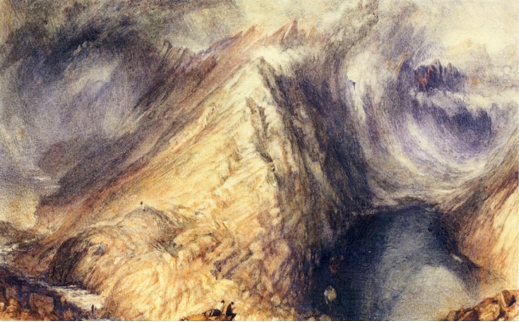Geoscientist 20.8 August 2010

After a trip to the North of the Scotland during the summer of 1831, J W M Turner (1775-1851) painted Loch Coriskin (Loch Coruisk), 1834, a watercolour that brings to the fore his surprisingly profound knowledge of geological form. The work is housed at the National Gallery of Scotland and belongs to Vaughan Bequest. At this time, Turner was creating illustrations to the works of Sir Walter Scott, and this watercolour was to form the frontispiece to Cadell’s edition of Lord of the Isles.
In the fourth volume of Modern Painters, Ruskin (a keen geologist himself) paid tribute to the precision of Turner’s geological observations. Turner had access to the Geological Society of London, founded in 1807, through his friendship with Charles Stokes and Francis Chantrey who were both prominent members. Stokes (1785-1853) was a wealthy stockbroker, amateur geologist, lithographer, antiquary, and collector. He was a Fellow of the Society of Antiquaries (1811) and of the Royal Society (1821) and later was elected Vice-President of the Geological Society. Stokes collected watercolours and Old Master prints widely, but Turner formed the core of his collection. He had a large collection of geological and natural history specimens, which Turner may well have seen.
Turner also knew the distinguished descriptive geologist John MacCulloch (1773-1835), from whom he acquired two volumes of Geological Society’s Transactions. Accounts in these volumes prompted Turner to tackle such subjects as The Eruption of the Souffrier Mountains, and Staffa, Fingal’s Cave. He made studies of Stonehenge and the Isle of Staffa and even wrote verses using technical geological language.
Turner possessed more than a mere smattering of geology. On the contrary, he appears to have had a profound knowledge of the new science. Turner was also probably aware of the scientific controversies of his time - not the least, those addressing the Earth’s formation, including the debate between “Neptunists” and “Plutonists”.
His watercolour plunges the viewer into one of the most dramatic scenery of Skye. Loch Coruisk is located in the Cuillin Mountains and is enclosed by rocks created about 55 million years ago by violent Tertiary volcanic activity that also created many of the Scottish Islands off the West Coast during the birth pangs of the North Atlantic. The so called “Red” and “Black” Cullins reflect geological differences in the composition (chemical and mineralogical) of the igneous rocks that form them (Red Cullins are made of a granite weathering to a reddish-pink, while the Black Cullins are largely made from gabbro).
In this picture, Turner focus on realistic details such as jagged mountains that bear witness to the role of the erosion over millions of years. This is not the first time that this painter has concentrated on such a scientific detail. In the early years of the 19th Century, Turner had already shown interest in cliffs and crags. His trip in the Alps, made during the Amiens Peace of 1802, was an opportunity to study the geology first hand, while other British painters (such as James Ward and later Charles Nemy) took a similar an interest in the depiction of cliffs, rocks and erosion. In this watercolour Turner has slightly exaggerated the steepness of the mountains, revealing his taste for the romantic. The grandeur of the scene comes very close to the sort of “sublime sentiment” enunciated by writer and philosopher Edmund Burke in 1757.
The cliffs are tinged with grey, blue and white and look like gigantic waves of stone. In the background, we observe purple on the slopes. In the foreground, two tiny persons are depicted, sitting on a cliff and bringing scale to the hugeness and the danger implicit in nature at her most violent and dramatic. Humanity is banished by this vastness, recalling Wordsworth’s near terror in the “elfin pinnace” incident from The Prelude, when “a huge Cliff/As if with voluntary power instinct/Uprear'd its head” and seemed to pursue him, through the thoughts of his days and dreams of his nights. More than any other picture of his output that depicts mountains, In Loch Coruisk Turner gives us a truly dynamic picture of nature in the raw.
Turner concentrates on the relationship between meteorological and geological phenomena at a time when the two sciences were still closely related. In Turner’s time, in scientific institutions such as the Geological Society and Royal Society, the natural sciences were perceived as an interconnected web: chemistry, geology, natural history, astronomy and even mathematics depended closely one upon the other – the kind of amalgamation that is only now recurring as natural sciences reunite under the banner of Earth System Science.
Further reading
- Finley, Gerald 1980: Landscapes of Memory – Turner as Illustrator to Scott, University of California Press.
* Dr Alexis Drahos is an art historian specialising in 19th Century landscape painting and the new science of geology. He lives in Paris.